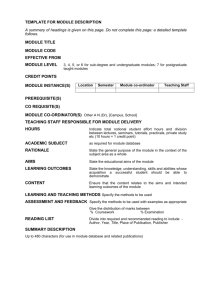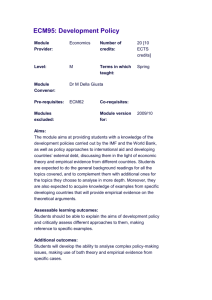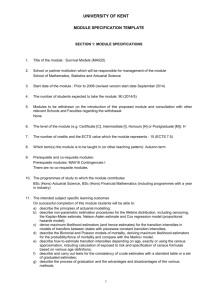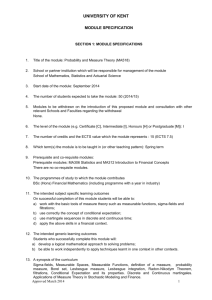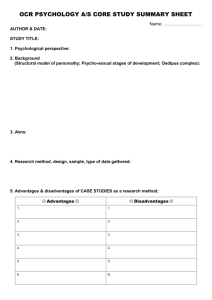learning outcomes - University of Ulster
advertisement
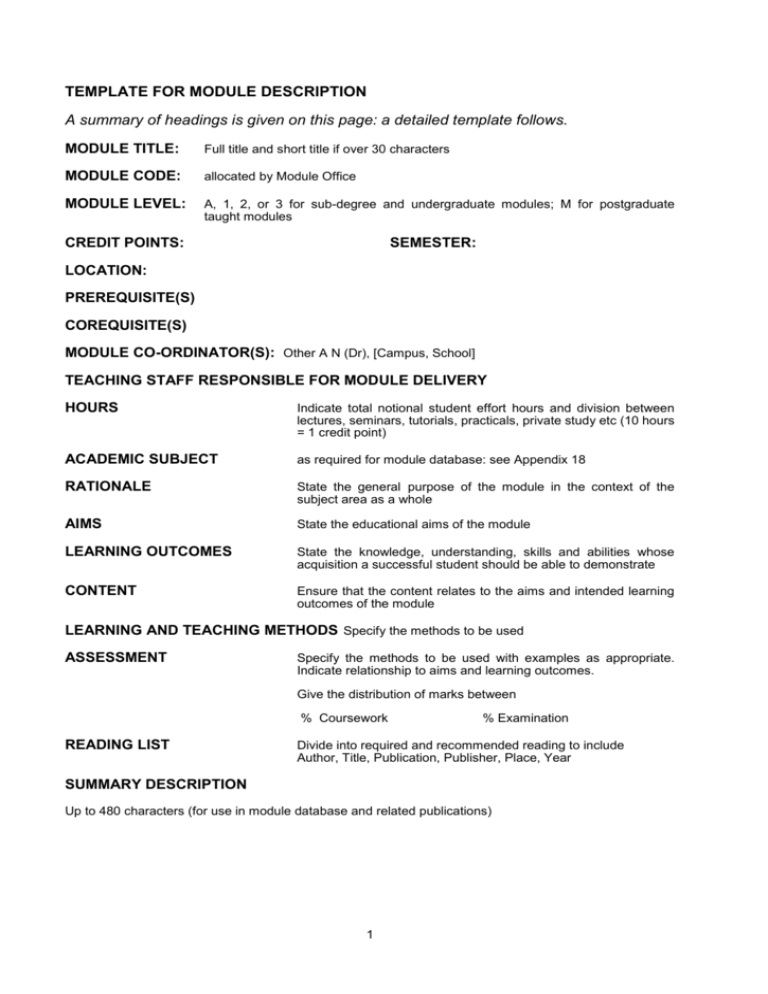
TEMPLATE FOR MODULE DESCRIPTION A summary of headings is given on this page: a detailed template follows. MODULE TITLE: Full title and short title if over 30 characters MODULE CODE: allocated by Module Office MODULE LEVEL: A, 1, 2, or 3 for sub-degree and undergraduate modules; M for postgraduate taught modules CREDIT POINTS: SEMESTER: LOCATION: PREREQUISITE(S) COREQUISITE(S) MODULE CO-ORDINATOR(S): Other A N (Dr), [Campus, School] TEACHING STAFF RESPONSIBLE FOR MODULE DELIVERY HOURS Indicate total notional student effort hours and division between lectures, seminars, tutorials, practicals, private study etc (10 hours = 1 credit point) ACADEMIC SUBJECT as required for module database: see Appendix 18 RATIONALE State the general purpose of the module in the context of the subject area as a whole AIMS State the educational aims of the module LEARNING OUTCOMES State the knowledge, understanding, skills and abilities whose acquisition a successful student should be able to demonstrate CONTENT Ensure that the content relates to the aims and intended learning outcomes of the module LEARNING AND TEACHING METHODS Specify the methods to be used ASSESSMENT Specify the methods to be used with examples as appropriate. Indicate relationship to aims and learning outcomes. Give the distribution of marks between % Coursework READING LIST % Examination Divide into required and recommended reading to include Author, Title, Publication, Publisher, Place, Year SUMMARY DESCRIPTION Up to 480 characters (for use in module database and related publications) 1 Module Description Template This description is drawn up in a standard format to facilitate the production of programme specifications. It is designed to describe the level of the module, what the student learns to do by undertaking it and how that performance is assessed. The template is laid out in table format, which you may choose to follow. Please type within the cells of the table to facilitate the maintenance of the standard format which you may choose to follow. Add or delete rows if necessary but it should not be necessary to add columns. Please fill in and then delete all italic text before you print it out. IN COMPLETING THIS MODULE SPECIFICATION PLEASE USE THE ARIAL FONT AND FONT SIZE 10 MODULE TITLE: Full title and short title if over 30 characters MODULE CODE: MODULE LEVEL: A, 1, 2, or 3 for sub-degree and undergraduate modules; or M or 3 for postgraduate modules. The level should be determined by reference to the level descriptors. CREDIT POINTS: 1 credit point per 10 hours of notional student effort. 10, 15, 20, 30 points for taught modules or 60 for postgraduate dissertation or project. SEMESTER: 1/2/3 or 1 and 2 (“long thin”). LOCATION: Campus (including Campus One for e-learning) or outcentre. PREREQUISITE(S) This relates to a module or modules which must be completed prior to start of this module. CO-REQUISITE(S) This relates to a module or modules which must be taken alongside this module. MODULE CO-ORDINATOR(S): Surname; Initials; TEACHING STAFF RESPONSIBLE FOR MODULE DELIVERY Surname; Initials; HOURS: Indicate total notional student effort hours and their division between lectures, seminars, tutorials, practicals, private study, etc (10 hours = 1 credit point) Lectures hrs Seminars hrs Tutorials hrs Practicals hrs Independent study (including assessment) hrs TOTAL EFFORT HOURS: This is the number of credit points multiplied by 10. It must match the total of effort hours detailed above. ACADEMIC SUBJECT: This is a code from the University of Ulster subject list. It could determine the first three letters of the module code and should relate to School or Sub-division of a School offering the module. 2 RATIONALE Please state the general purpose of the module in the context of the subject area as a whole . AIMS Please state the essential aims of the module. These aims should lay the foundation for the learning outcomes, the learning and teaching methods and assessment outlined in this description. LEARNING OUTCOMES Learning Outcomes should be statements of the minimum that a student will be able to do when they have completed the module. Learning outcomes should: be written in the future tense; identify important learning requirements; be achievable and assessable; and use language that students can understand. Further advice is available from the University of Ulster Assessment Handbook. Adapt the following table to suit your needs. The categories are those used in the Course Specification. Not all categories need be addressed in each module and the number of learning outcomes is not fixed. Learning outcomes should be compatible with the level descriptors. See Appendix 7 of the Course Approval, Management and Review handbook for further information. Follow a numbering scheme since these will be referred to in the Assessment section and will assist in drawing up a course specification. You may wish to identify learning outcomes that are not essential (i.e. above the minimum) but which nevertheless add value. These need not be assessed. Do not number them. A successful student will be able to show that he/she can: KNOWLEDGE AND UNDERSTANDING K1 K2 K3 K4 INTELLECTUAL QUALITIES I1 I2 I3 I4 3 PROFESSIONAL/PRACTICAL SKILLS P1 P2 P3 P4 TRANSFERABLE/KEY SKILLS S1 S2 S3 S4 CONTENT Ensure that the content relates to the aims and intended learning outcomes of the module LEARNING AND TEACHING METHODS Explain why these methods are being employed from a student perspective. Where appropriate, cross-reference the teaching methods to the intended learning outcomes. Lectures will… Seminars will… Tutorials will… Practical exercises will… Students will be directed to read… Students will be expected to … Add extra Learning and Teaching Methods as relevant 4 ASSESSMENT Indicate the methods to be used, with examples as appropriate. Cross-reference each assessment method to the learning outcomes to indicate how the achievement of each learning outcome is being assessed. Coursework 1: This should comprise a short description of the type of work involved an indication of its percentage contribution the module learning outcomes assessed (cross reference to the Learning Outcomes Section) Do not be too specific since you may wish to vary the methods from time to time. Appropriate use of exemplars will be useful here. The emphasis should be on how this method indicates a student’s ability to achieve the specified learning outcomes. This assignment will measure the student’s achievement of module learning outcomes insert the appropriate learning outcome number from your list of this module’s learning outcomes Coursework 2: if relevant As above Examination: if relevant This might comprise a short description of the examination in terms of: how many questions in how long? the extent of choice within the paper? how many sections? open or closed book? compulsory sections etc. Exemplars: A 3-hour paper with between 5 and 8 questions in which there will be an element of choice. Learning outcome K1, I2 and P2 will be assessed OR A 2-hour paper in two sections. Section one will be compulsory and assess Learning Outcomes K1-3, P1 and S1. Section two will contain an element of choice and assess learning outcomes K2-4, I1-3 and S2 The examination will measure the student’s achievement of learning outcomes cross-reference to your list of this module’s learning outcomes Give the distribution of marks between coursework and examination % Coursework % Examination READING LIST List all required and indicative recommended reading. These should include electronic sources. Use the Harvard referencing system throughout. Required Recommended SUMMARY DESCRIPTION Up to 480 characters (for use in module database and related publications) 5
